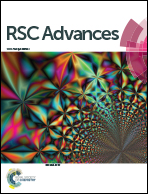One/two-photon-sensitive photoacid generators based on benzene oligomer-containing D–π–A-type aryl dialkylsulfonium salts†
Abstract
Novel sulfonium-based D–π–A photoacid generators (PAGs) with a benzene oligomer (from one to four) as a π-conjugated system that are highly photosensitive in the near-ultraviolet region (365 nm) were prepared. The maximum absorption and molar extinction coefficients of the PAGs redshifted and enhanced with the increasing length of the conjugated systems. The quantum yields of PAGs were high (three of them were over 0.6) and improved by adjusting the number of the phenyl rings. The quantum chemical calculation results proved that the molecular configuration and nature of the frontier orbitals are crucial factors which affect PAG performance. Photopolymerization kinetic results demonstrated that these sulfonium-based PAGs were highly efficient cationic photoinitiators, and the i-line sensitivities were evaluated based on the photolithographic performance of the PAG-containing SU-8 resins. In addition, the two-photon absorption cross sections (δ700 nm > 400 GM) matched the requirements needed in the 3D fabrication of polymer microstructures.


 Please wait while we load your content...
Please wait while we load your content...